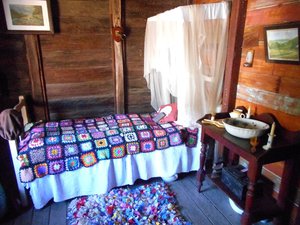Advertisement
Published: August 11th 2014

 Rosewood Homestead, Heritage Village
Rosewood Homestead, Heritage Village
One of the bedrooms had a crocheted squares blanket and a rag rug, typically made from pieces of old clothing during the war and Great Depression just like one in my grandmother's house.Today we went to see the Heritage Village, as it had free entry due to the Emergency Services Day. The event has been going for seven years and shows the locals what the various emergency organisations can do. It also gives people information on what they can do to prevent or cope with any emergency or disaster.
We entered through the Information Centre and picked up maps for both the event and the usual Heritage Buildings and Museums. The first thing we saw was a display of clocks dating from 1630, that had been collected by the local watchmaker, Ernie Gomershall, and his family over many years. They included Grandfather Clocks, Cuckoo Clocks and some obviously French clocks. Many were similar to each other and most of them weren’t labelled, so it was hard to tell which was the oldest or where they came from. A couple stood out as different, though, like the clock that was set into a rather garish china galleon with blue sails (not one I would want but fun in the right home) and the pretty glass case with a Swiss Movement Fob Watch inside that had been bought as a souvenir of

 SES to the Rescue
SES to the Rescue
The SES demonstrated how they cover storm damaged roofs by doing so on Dingley Cottage in the Heritage Village, so we never did get inside this one!the Imperial International Exhibition in London in 1909 and had a picture of London on the top.
By the time we had entered the village, some of the Emergency Displays being shown around it had finished, (and some we chose to miss so we could go around the village too) such as the building of a flood barrier in front of St Peter’s Church by the SES, covering Dingley Cottage and the Church roofs as if they had been storm damaged (we did see them all taken down later, though) and the Simulated House Fire Display. We saw the SES Chain Saw Demonstration, basically just cutting a tree into small pieces, (although I was happy to see that it was a woman who was in charge and training two young men) as well as some of the Rural Fire Services Pump Operations in the Main Arena. There was also supposed to be a visit and Winch Rescue Display by the RACQ Capricorn Helicopter Rescue Service but it was called out to two different rescues that afternoon and so wasn’t available (obviously a service that is vitally needed in the area!).
We were very surprised,

 A Field Hospital, Emergency Services Day
A Field Hospital, Emergency Services Day
This hospital is actually a tent with inflatable ribs running through it (the dark lines), fly netting windows and an attached floor which can be erected in minutes.during our wandering around the Village, to find a very large Field Hospital tent with sealed floor, which was designed to blow up quickly and could house about twenty beds. It had come from the Tactical Support Truck, along with huge boxes full of supplies and equipment for any emergency situations or disasters. It was most impressive the way everything was packed and stored in the truck.
I was also very surprised at how many buildings there were in the Heritage Village, ranging from small cottages to a Church, a School and a Railway Station. Most of them were genuine old buildings that had been due for demolition or were decaying at their original sites and were donated or acquired by the Museum and relocated to this site, while a few were replicas, such as the Charles Street Fire Station (because the building is still standing and in use in its original site) which houses a small Fire Museum with some old fire engines and lots of early fire fighting equipment; and the primitive Timber Cutter’s Camp.
The three houses, Woods Cottage and Barn from the early 1900s; Rosewood Homestead and Kitchen, built in

 The Aviation Rescue Fire Fighting Truck
The Aviation Rescue Fire Fighting Truck
This amazing truck could fire that jet of water clear across the arena as well as shooting smaller jets out lower and creating a mist under the vehicle to stop it catching fire, itself.1888 and having pressed metal walls and ceilings from Britain; and Rackemann’s Cottage, an early pioneer slab hut; were all wonderfully furnished inside in styles that would have been appropriate to the time and status of the owners. It brought back memories to see an old rag rug in one bedroom, as my grandmother used to have one in her kitchen in London, made out of old clothes during the war period. We had also owned a crocheted squares blanket like the one on the bed, when I was growing up (in fact it was rather disturbing to see how many of the items on display were ones I remember from my childhood – I can’t be old enough to be at home in a museum yet!)
Other, larger, buildings were used to house a wide range of collections, including historic commercial and farming vehicles; vintage cars and bikes; horse drawn carts and wagons; vintage generators and stationary engines; and a doll collection (which had some of the trolls with the wild brightly coloured hair I remember as a child and that made a come-back under a different name when my kids were young and an almost

 A Relieving Shower on a Hot Day
A Relieving Shower on a Hot Day
The Aviation Rescue Fire Fighting Truck crew invited all the children onto the arena to play in the water jet (turned down low and sprayed from high up so it was like a gentle rain) and they flooded in from all around the field.life sized doll similar to one I was given as a young girl and it was nearly as tall as me.)
In fact, the Heritage Village was like a whole group of museums brought under one umbrella. One of the stand-outs was the Kianga Shearing Shed, which came from Moura and was built from a 1930s kit produced by the Southern Cross Company. It was completely kitted out as a working shearing shed from days gone by, and included all the equipment, like wool balers, sorting tables, and both hand blade shearers and mechanical shearers, as well as samples of the various wool types and stories about the gun shearers (the top shearers who could shear a large number of animals in one day). One man, Jack Howe, set an amazing record in 1892, by shearing 321 sheep with blade (hand) shears in 7 hours and 45 minutes, (a record which stood until 1950 and was broken by someone using machine clippers) and had also previously set a weekly aggregate record of 1,437 sheep in 44 hours and 30 minutes (a record which stood until 2005!). He must have had super powers!
The best

 Brightly Coloured Trolls
Brightly Coloured Trolls
Part of the Doll Collection at the Heritage Village, these Trolls, with their wild hair, first came out when I was a child and returned under a different name when my kids were young.of all the museums here was undoubtedly the Country Hospital Museum, housed in the 1946 Mount Morgan Matron and Sisters’ quarters. It was set out so that each room showed the history of various aspects of the medical profession including medical, nursing, dental, radiology, pharmacy and hospital services from 1858 to 1968. It had a fully equipped operating room, with a patient in it being operated on; a general ward, with patients in bed and a nurse attending them; a premature delivery room with babies in the humidicribs; a dental surgery, full of nasty looking implements; a pharmacy; a cleaning room full of bedpans, fortunately clean ones, and the equipment used to sterilise stuff; a nurse’s bedroom, with an old style uniform on a hanger; and a display about the Iron Lung and poliomyelitis and the role played by Australian Sister Elizabeth Kenny, who came up with a radical new treatment for the rehabilitation of polio survivors in the early 1900s which she took to the Europe and the USA. Overall, it was an amazing display and could easily have been a stand-alone museum that you would pay to go and see.
We had stopped for a

 The Operating Theatre Display
The Operating Theatre Display
This is just one of the many amazing replica rooms in the Country Hospital Museum within the Heritage Village. Note the chloroform mask on the left, an early anesthetic.drink, (all that walking was thirsty work in the sun!) just as the Aviation Rescue Fire Fighting Truck came onto the arena so we watched the display. The truck was bright yellow, as are all aviation rescue vehicles, and quite long. It had an enormous nozzle at the top that could (and did) send a jet of water across the length of the field and high up into the air (as they demonstrated by water over a row of tall trees). We were told that they were not even using the full power it was capable of and it was already very impressive. Obviously, they would normally have some fire retardant chemicals in the water stream in a real emergency, but they only used water for the demo. It also had some smaller nozzles that could direct jets to the underside of planes and even had a sprinkler system covering the bottom of their own vehicle with a fine spray to prevent it catching fire, itself. It was great to watch as I had never seen one in action before.
Their finale was the best part, though, (making up for the RACQ helicopter’s non-appearance, I think). They

 A Ward in the Country Hospital Museum
A Ward in the Country Hospital Museum
This was another of the wonderfully realistic display rooms which used authentic equipment and dummies very effectively. set the water hose going high up into the air at half strength and invited all the kids to come onto the field and run around under the spray. As soon as they gave the word, hoards of kids raced across the field towards the unit at the far end, some dragging parents along, too. It had been hot in the sun and so they were having a wonderful time rushing about through the water stream. After about five minutes, though, the unit ran out of water, much to the kids’ disappointment. It had been a really good finale to the event.
We had not expected to see so much at the Village or for it to take so long to go around. We filled in most of the day there and were totally exhausted (and hungry, as we hadn’t brought lunch with us) by the time we got back to the van. Amazing!
Advertisement
Tot: 0.115s; Tpl: 0.014s; cc: 15; qc: 53; dbt: 0.0697s; 1; m:domysql w:travelblog (10.17.0.13); sld: 1;
; mem: 1.2mb











